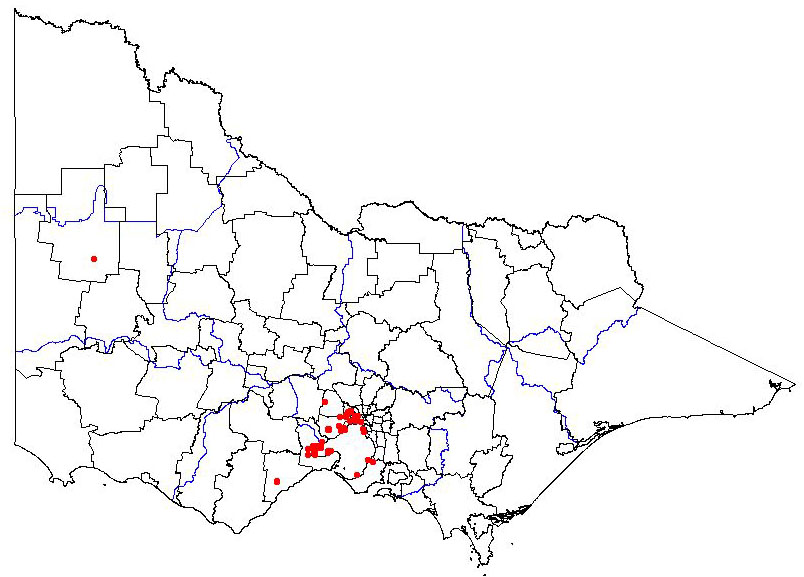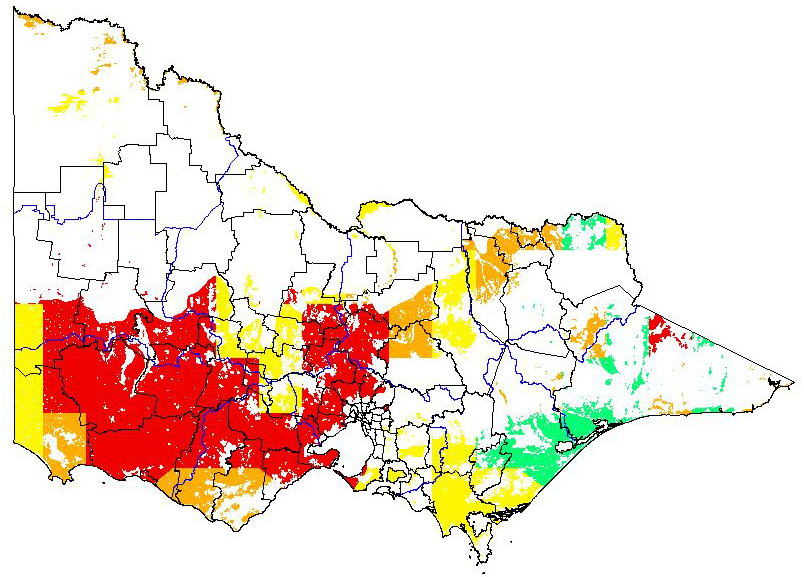African thistle (Berkheya rigida)
Present distribution
|  Map showing the present distribution of this weed. | ||||
| Habitat: Subhumid warm-temperate to subtropical regions, principally on loose sandy soils and occasionally on better class soils inland (Parsons and Cuthbertson 1992). It is a weed of coastal areas, pastures, recreational areas, roadsides and watercourses (Bond and Goldblatt 1984, Parsons and Cuthbertson 1992). African thistle invades dry coastal vegetation and lowland grassland and grassy woodland (Carr et al 1992). | |||||
Potential distribution
Potential distribution produced from CLIMATE modelling refined by applying suitable landuse and vegetation type overlays with CMA boundaries
| Map Overlays Used Land Use: Pasture dryland Broad vegetation types Coastal scrubs and grasslands; grasslands; plains grassy woodlands; coastal grassy woodland; herb-rich woodlands; riverine grassy woodlands; rainshadow woodlands; mallee woodland; heathy woodland; wimmera mallee/woodland; inland slopes and sedge-rich woodlands. Colours indicate possibility of Berkheya rigida infesting these areas. In the non-coloured areas the plant is unlikely to establish as the climate, soil or landuse is not presently suitable. | 
|
Impact
QUESTION | COMMENTS | RATING | CONFIDENCE |
| Social | |||
| 1. Restrict human access? | ‘Stiff herbaceous to woody perennial herb 30 to 80cm high’ ‘Large colonies .. in recreational areas, may prevent access to beach and facilities’ (Parsons & Cuthbertson 1992). Spiny plant. Depending on where plant is found, may impede individual access. | ml | mh |
| 2. Reduce tourism? | ‘Large colonies .. in recreational areas, may prevent access to beach and facilities’. Yellow flowers grouped into small terminal heads (Parsons & Cuthbertson 1992). ‘..has proved a source of annoyance to campers attracted by the fishing possibilities’ (Meadley 1956). Some recreational uses affected. | mh | h |
| 3. Injurious to people? | ‘The spines are disconcerting to even well-seasoned bare feet and can be very disturbing if they penetrate blankets’ (Meadley 1956). Spines at most times of the year. | mh | h |
| 4. Damage to cultural sites? | Plant not documented to cause damage to indigenous or European cultural sites. | l | mh |
| Abiotic | |||
| 5. Impact flow? | Terrestrial species (Parsons & Cuthbertson 1992). | l | mh |
| 6. Impact water quality? | Terrestrial species (Parsons & Cuthbertson 1992). | l | mh |
| 7. Increase soil erosion? | Stems to 1m long rooting wherever they contact the soil. ‘A short thick rootstock giving rise to several robust rhizomes and an extensive, much branched mass of feeding roots in the surface layers’ ‘Aerial growth dies in late summer or early autumn’ (Parsons & Cuthbertson 1992). Plant can form colonies and bare soil exposed at some times of year when aerial growth dies off. Moderate probability of large scale soil movement. | ml | mh |
| 8. Reduce biomass? | ‘Stiff herbaceous to woody perennial herb 30 to 80cm high’ (Parsons & Cuthbertson 1992). Can form colonies and tends to be found in open areas. Although the aerial growth dies off in summer / autumn, biomass may increase. | l | mh |
| 9. Change fire regime? | ‘Aerial growth dies in late summer or early autumn’ (Parsons & Cuthbertson 1992). Plant can form colonies and tends to be found mostly in open areas. Possible that Plant could contribute to intensity of fire. | ml | mh |
| Community Habitat | |||
| 10. Impact on composition (a) high value EVC | EVC = Coastal headland scrub (BCS= E); CMA= Glenelg Hopkins; Bioreg= Glenelg Plain; CLIMATE potential =VH. Forms colonies (Marchant et al 1987). Major displacement of some dominant species within the lower strata. | mh | mh |
| (b) medium value EVC | EVC = Heathy herb rich woodland (BCS= D); CMA= Glenelg Hopkins; Bioreg= Glenelg Plain; CLIMATE potential =VH. Forms colonies (Marchant et al 1987). Major displacement of some dominant species within the lower strata. | mh | mh |
| (c) low value EVC | EVC = Heathy woodland (BCS= LC); CMA= Glenelg Hopkins; Bioreg= Glenelg Plain; CLIMATE potential =VH. Forms colonies (Marchant et al 1987). Major displacement of some dominant species within the lower strata. | mh | mh |
| 11. Impact on structure? | Found in dry coastal vegetation and lowland grassland and grassy woodland (Carr et al 1992). Forms colonies (Marchant et al 1987). Major effect on lower strata. | mh | mh |
| 12. Effect on threatened flora? | This species is not documented as posing an additional risk to threatened flora. | mh | l |
| Fauna | |||
| 13. Effect on threatened fauna? | This species is not documented as posing an additional risk to threatened fauna. | mh | l |
| 14. Effect on non-threatened fauna? | Weed can form colonies and tends to be found in open areas (Parsons & Cuthbertson 1992). Possible that may lead to a minor reduction in food for non-threatened fauna species. | ml | mh |
| 15. Benefits fauna? | Spines make it unpalatable to stock (Parsons & Cuthbertson 1992). Provides very little support to desirable species. | h | mh |
| 16. Injurious to fauna? | Spines make it unpalatable to stock (Parsons & Cuthbertson 1992). Spines at certain times of the year. | mh | mh |
| Pest Animal | |||
| 17. Food source to pests? | Plant not documented as food source for pest species. | l | mh |
| 18. Provides harbor? | Plant not documented as providing harbour for pest species. | l | mh |
| Agriculture | |||
| 19. Impact yield? | ‘Large quantities .. limit pasture growth and available grazing area’ (Parsons & Cuthbertson 1992). Quantity of pasture growth may be reduced. | ml | mh |
| 20. Impact quality? | Weed not documented to impact upon agricultural quality. | l | mh |
| 21. Affect land value? | Weed not documented to affect land value. | l | mh |
| 22. Change land use? | Weed not documented to cause a change in priority of land use. | l | mh |
| 23. Increase harvest costs? | Weed is difficult to control (Parsons & Cuthbertson 1992) and where growing in pastures would require more time and labour to remove. | m | mh |
| 24. Disease host/vector? | Weed not documented as a host or vector for disease of agriculture. | l | mh |
Invasive
QUESTION | COMMENTS | RATING | CONFIDENCE |
| Establishment | |||
| 1. Germination requirements? | Seed germinate in autumn (Parsons & Cuthbertson 1992). Rhizomes probably germinate whenever sufficient moisture is available. Generally requires natural seasonal conditions for germination. | mh | mh |
| 2. Establishment requirements? | Only known to est. in areas that are ‘open’.→ Coastal areas, paddocks used for grazing (Parsons & Cuthbertson 1992). Requires more specific requirements to establish. | ml | mh |
| 3. How much disturbance is required? | Establishes in coastal areas of Australia (Parsons & Cuthbertson 1992) & areas with a great impact by humans – camping sites (Meadly 1965). Also invaded lowland grassland & grassy woodland (Carr et al 1992). Can establish in minor disturbed natural ecosystems. | mh | mh |
| Growth/Competitive | |||
| 4. Life form? | Herbaceous to woody perennial thistle (Parsons & Cuthbertson 1992). Creeping perennial habit (Meadly 1965). Lifeform – creeper | ml | mh |
| 5. Allelopathic properties? | None described. | l | mh |
| 6. Tolerates herb pressure? | Its spines make it unpalatable to stock (Parsons & Cuthbertson 1992). Favoured by heavy grazing pressure as not eaten by animals. | h | mh |
| 7. Normal growth rate? | ‘Aerial growth is slow at first as the plant establishes an extensive underground system .. growth rate increases in late winter to early spring’ (Parsons & Cuthbertson 1992). Maximum growth rate less than many species of same life-form. | ml | mh |
| 8. Stress tolerance to frost, drought, w/logg, sal. etc? | Tolerant of fire (rhizomes); drought (occurring dry/arid areas of Aust. (Eg. Perth)). Establishes in coastal areas of Australia (Parsons & Cuthbertson 1992) – possible that is tolerant of salinity. Found in areas in south Victoria where occasional frosts occur. Highly tolerant of at least 2, maybe tolerant of another. Maybe susceptible to waterlogging. | mh | mh |
| Reproduction | |||
| 9. Reproductive system | Seeds & rhizomes (Parsons & Cuthbertson 1992). Both vegetative and sexual reproduction. | h | mh |
| 10. Number of propagules produced? | Production of a large number of seeds (Meadly 1965). Insufficient information to determine number of propagules produced. | m | l |
| 11. Propagule longevity? | Seeds may remain dormant for several years in the soil (Meadley 1965). Seeds survive for less than 5 years. | l | mh |
| 12. Reproductive period? | Perennial; can form large colonies consisting of matted stems (Parsons & Cuthbertson 1992). Species can form self-sustaining dense monocultures. | h | mh |
| 13. Time to reproductive maturity? | Seeds germinate in autumn→ growth occurs during winter/early spring→ flowering Nov/Dec (Parsons & Cuthbertson 1992). Less than one year to reach reproductive maturity. | h | mh |
| Dispersal | |||
| 14. Number of mechanisms? | ‘Burr is easily caught up in the coats of passing animals or kicked along by their hooves. Some seed falls from burr as it is carried of roll along’ (Parsons & Cuthbertson 1992). Possibly also water dispersal (Carr et al 1992). Propagules spread by animals and water. | mh | mh |
| 15. How far do they disperse? | Colonies increase in size & density, locally, or as a result of regrowth from rhizomes. Most seed has probably only dispersed 20m. Meadly (1965) also noted spread of the weed to be slow. | l | mh |
References
Australian National Herbarium (ANH) 2006, Australia’s Virtual Herbarium, Australian National Herbarium, Centre for Plant Diversity and Research, viewed, http://www.anbg.gov.au/avh/
Department of Sustainability and Environment (DSE) 2004, Flora information system [CD-ROM], Biodiversity and Natural Resources Section, Viridans Pty Ltd, Bentleigh.
Global Biodiversity Information Facility (GBIF) 2006, Global Biodiversity Information Facility, Data portal, viewed 01 Aug 2006, http://www.gbif.org/
Marchant, N.G. et al. 1987, Flora of the Perth region (Part 2), Western Australian herbarium, Western Australia.
Meadley, G. 1956, ‘Weeds of western Australia: Berkheya rigida’, Journal of Agriculture, vol. 5, no. 4, pp. 453-455.
Parsons, W.T. & Cuthbertson, E.G. 1992, Noxious weeds of Australia, CSIRO Publishing, Collingwood.
Global present distribution data references
Australian National Herbarium (ANH) 2006, Australia’s Virtual Herbarium, Australian National Herbarium, Centre for Plant Diversity and Research, viewed, http://www.anbg.gov.au/avh/
Global Biodiversity Information Facility (GBIF) 2006, Global Biodiversity Information Facility, Data portal, viewed 01 Aug 2006, http://www.gbif.org/
Marchant, N.G. et al. 1987, Flora of the Perth region (Part 2), Western Australian herbarium, Western Australia.
Feedback
Do you have additional information about this plant that will improve the quality of the assessment?
If so, we would value your contribution. Click on the link to go to the feedback form.


